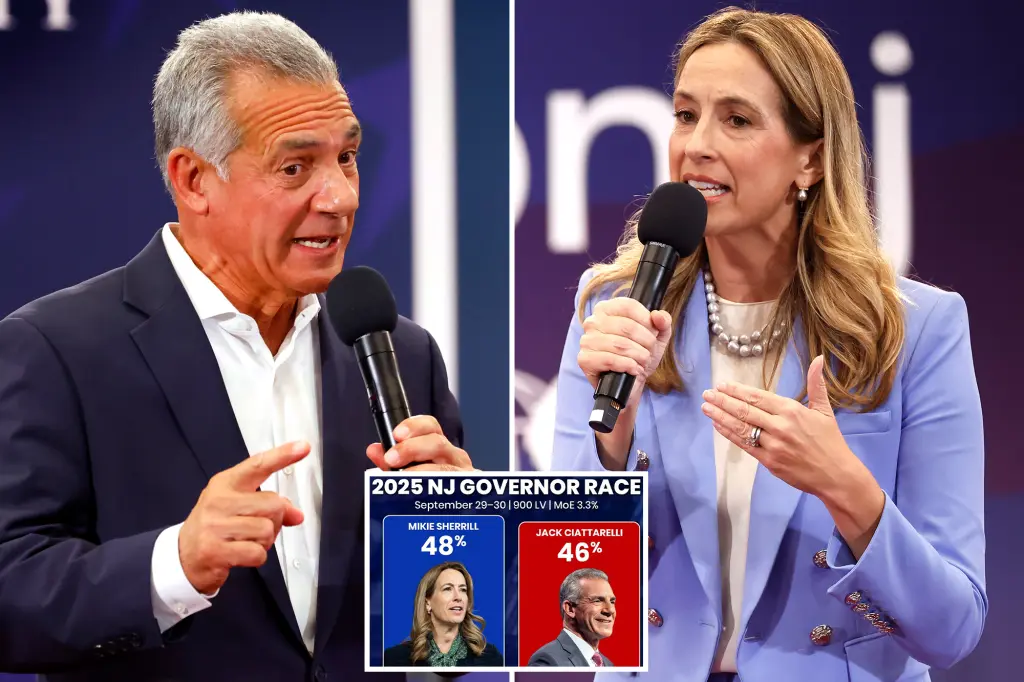Ciattarelli Narrows Gap in New Jersey Governor’s Race Against Sherrill
In a dramatic shift in the New Jersey gubernatorial race, Republican candidate Jack Ciattarelli has significantly narrowed the gap against Democratic Representative Mikie Sherrill, according to recent polling data. What once appeared to be a comfortable lead for Sherrill has transformed into a neck-and-neck contest that could potentially result in a Republican upset in traditionally blue New Jersey. The Quantus Insights Poll shows Sherrill with a razor-thin lead of 48.1% to Ciattarelli’s 45.8% among likely voters—a margin that falls within the poll’s error range. This represents a remarkable comeback for Ciattarelli, who was trailing by approximately 10 percentage points in polling conducted around Labor Day. The shifting dynamic reflects growing voter sentiment across the state, with 76% of respondents indicating they desire change in New Jersey’s leadership.
Perhaps most concerning for the Sherrill campaign is Ciattarelli’s commanding lead among Independent voters, where he holds a substantial 51% to 38% advantage. This crucial voting bloc often determines election outcomes in competitive races, and Ciattarelli’s strong performance with Independents mirrors similar patterns that have led to Republican victories in other recent gubernatorial races across the country. Political analysts point to several factors driving this shift, including economic concerns, property tax burdens, and a desire for new approaches to persistent state issues. Ciattarelli, who narrowly lost his previous gubernatorial bid against Phil Murphy in 2021, appears to be leveraging his experience and name recognition while appealing to voters across traditional party lines with pragmatic messaging focused on kitchen-table issues.
The tightening race is not reflected in a single poll but appears across multiple surveys, lending credibility to the trend. Emerson College Polling and internal campaign polling have similarly characterized the contest as a dead heat in recent weeks. These findings suggest that Ciattarelli’s momentum is real rather than an anomaly in a single survey. The RealClearPolitics polling aggregate, which combines multiple polls to provide a broader picture of the race, now shows Sherrill with just a 4.7 percentage point advantage—a far cry from the comfortable lead she enjoyed earlier in the campaign. Political observers note that this same polling aggregate underestimated Ciattarelli’s performance by approximately five percentage points in his 2021 gubernatorial run, raising the possibility that he could be even closer to Sherrill than current numbers suggest.
While some polling still shows Sherrill maintaining a lead, the trajectory clearly favors Ciattarelli as Election Day approaches. A Fox News poll released Tuesday indicates Sherrill ahead by 8 points (50% to 42%) among likely voters—still a competitive race, but more favorable to the Democrat than other recent surveys. The varying results across different polls highlight the volatility and uncertainty surrounding this election, with methodology differences and likely voter models potentially explaining some of the discrepancies. What remains consistent, however, is the narrative of Ciattarelli gaining ground and Sherrill struggling to maintain her earlier advantage, creating genuine competition in a race many had previously considered safe for Democrats.
Sherrill, a former Navy helicopter pilot and federal prosecutor who has represented New Jersey’s 11th congressional district since 2019, entered the gubernatorial race with strong credentials and name recognition. Her moderate positioning and record of working across the aisle in Congress initially made her an appealing candidate in a state that, while predominantly Democratic, has occasionally elected Republican governors like Chris Christie. However, Ciattarelli has effectively positioned himself as a pragmatic alternative rather than an ideological warrior, focusing his campaign on New Jersey-specific issues like property tax reform, education, and economic development. His approach appears to be resonating with voters who may approve of Sherrill personally but desire a different direction for state leadership after years of Democratic control under Governor Murphy.
As the race enters its final stretch, both campaigns are intensifying their efforts to mobilize voters and secure victory in what could be one of the most closely contested gubernatorial elections in New Jersey’s recent history. The Ciattarelli campaign has gained momentum at a critical juncture, while Sherrill’s team must now work to halt his advance and reassert her earlier advantages. For New Jersey voters, the tightening race offers a meaningful choice between two experienced candidates with different visions for the state’s future. Whether Ciattarelli can complete his comeback and pull off an upset victory or Sherrill can maintain her narrowing lead will likely depend on turnout patterns, late-deciding voters, and the effectiveness of each campaign’s closing arguments. What started as a seemingly predictable contest has evolved into one of the most watched races in the country, with potential implications for both parties’ strategies in future elections.


